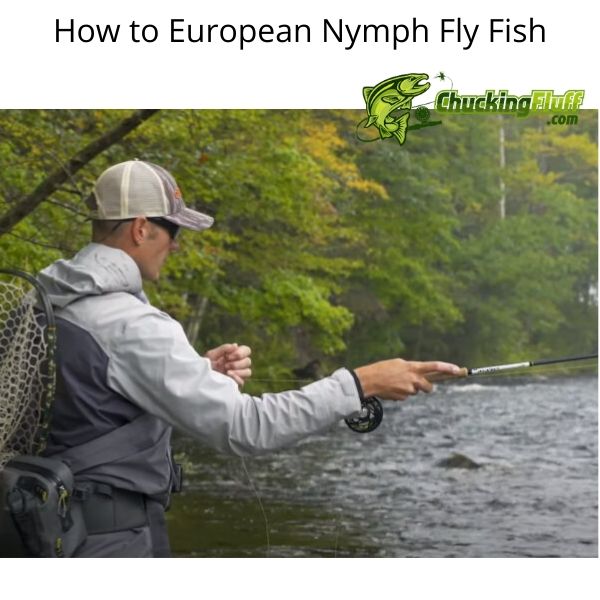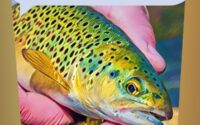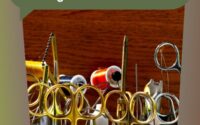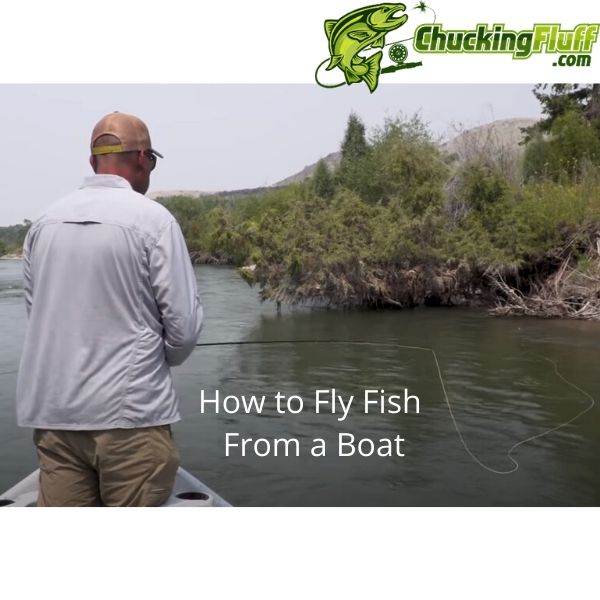| Disclosure: Just to be open and honest the buttons and links you click on in the website will in most cases take you to another website where you can purchase the products I am reviewing. As an Amazon Associate I earn from qualifying purchases. |
How to European Nymph Fly Fish – No Bobber, No Weights
Euro-nymphing methods were first introduced in competitions in the 1980s. Since then, the technique has grown with various special rigging and casting methods.
The rules are strict and to stick to the game, you have to adhere to them. Anglers are to use leaders as they are without attaching anything to them. There shouldn’t be any strike indicator or split shot. You shouldn’t have anything to float or sink your flies.
Nymph fly fishers had to come up with a strategy to get into the competition, take part, and possibly win if the rules were followed to the later. Nymphing anglers know that fish love to feed on the subsurface bugs.
If you have been nymph fishing, you can agree that you can fish this style almost throughout the year even if fish are underwater in the offseason or shoulder months.
Quick Post Navigation
What was the Strategy for European Nymphing?
It was a secret then. You can’t be sharing your secret winning strategy to all and sundry. Fortunately, it is no more a secret but how well you can execute each step of Euro nymph fly fishing.
First, you needed to know how your flies will get to the fish depth as you shouldn’t use a split shot. Also, you need to identify how to determine subtle strikes minus a strike indicator.

This leads us to the question: What Euro-nymphing is
Euro-nymphing is among the fly fishing techniques where an angler high-sticks their leader above or sometimes off the water. This increases the ability to feel a trout or other fish taking the fly.
These flies are heavily weighted. You can commence this technique by changing the leader and fly. However, we recommend getting a longer rod of about 10’ and a lighter line which is 3 or 4 weight.
The strategy came from finding solutions to the two primary issues that you needed to do without but ace the competition.
Goodbye Split Shot, and Welcome Weighted Flies
The issue of doing away with the split shot bore the idea of weighted flies. How was this done? Expert anglers cracked their minds and discovered that they could replace brass with heavier material like denser tungsten which was placed in the beads.
A lead wire was added to the body to increase the weight of the flies. Doing this made the fly sink faster. Another method to prevent the nymphs from hanging up more was tying the majority of flies like jigs. The hooks faced upwards.
What’s Up, Colorful Leaders?
The next challenge was having to fish without any strike indicators. But, you still had to find an optional way of detecting the subtle strikes. Using a brightly colored nymph leader came in as a handy tactic.
Expert Euro-nymphers say that it works better than the bobber indicators. Various sections have their various colors to give the angler a sense for more strike indication and depth.
Then, you could add a brighter section to the leader by tying it for visibility. Nowadays, manufacturers do this for us.
Studying the Leader
When you notice your Euro-nymphing leader pausing or getting straighter, it is an indication to set your hook. High-sticking your leader high over water ensures you are more focused and are in touch with your fly.
There will be zero discontinuities made by strike indicators and split shots.
Why do you think you should Euro-Nymph as a Fly Fishing Technique?
Euro-nymphing pros are sticking more to this technique than any other. Also, most guides are recommending it and giving more instructions on this skill to their learners. It must be worth it. No, it is more than what you think.
Longer rods fine-tunes specifically for this fly fishing technique are essential for larger lakes and rivers. However, if you are fishing smaller streams, consider the rod length.
Working on eddies and small pockets needs you to have increased precision. This gives the angler an advantage on both small streams and larger waters.
You need this technique in whichever river regardless of size. Pros prefer being closer in touch with your catch than casting across the currents towards the other side.
Once you are continuously connected to your fly, detecting more strikes will be easier. This will give the best hook-up rates.
It is a fancy technique. Maybe very expensive. NO! You don’t have to run bankrupt to start Euro-nymphing. It can cost you below $100 and still have your flies deeper to the fish level. At this cost, you can change your flies and leaders. However, if you can save for the recommended Euro-nymphing gear, the better.
Types of Euro-nymphing
Europe is a big continent with many countries. This gives the availability of different types of Euro-nymphing. These styles include Spanish, French, Polish, and Czech nymphing techniques.
Czech Nymphing
The Czech nymphing style is among the most famous techniques in Euro-nymphing contests. Here, an angler uses short casts with several weighted nymphs placed on a slightly shorter leader than the fly rod.
You have to swing these flies upstream and pause while they sink. Eliminating slack from your leader will require you to raise your tip and lead the flies.
Casting will have you snapping your wrist-not the same way you set the hooks. This will direct your leader and flies right behind you before they swing upstream.
Most pros describe this as lobing flies upstream. Remember it isn’t a back cast.
Nymphs of Czech nymphing are tied on hooks with a rounded style like grubs, caddis larva, and such insects. Their bodies are dubbed and have ribbing and shellback.
To grab your catch’s attention, you need a colorful hotspot. The nymphs have narrow profiles to allow quicker sinking.
French Nymphing
French nymphing will need you to use longer leaders of between 12 and 20 feet. Flies are smaller compared to the three other Euro-nymphing styles. Casting is directly upstream.
Anglers pull on their flies as they drift instead of leading or following their flies. To allow longer leaders to be useful, you are to cast some of the fly lines. By doing this, you can reach the fish quite far away.
You can also work on slower waters across faster seams. Flies for French nymphing are smaller than those used in Polish and Czech styles. Larger flies will be unwieldy on longer leaders.
Spanish Nymphing
Spaniards are known to use longer leaders and presentations than French Nymphing. Their style isn’t so different from the French Nymphing geography. The rod lengths are exceptional.
This technique for the Spaniards depends on lob casts because of the flies’ weights and the upstream presentation. Rather than leading your flies through their drifts as a result of longer casts, this technique will require line retrievals as it comes downwards with currents.
You will achieve this with a figure 8 retrieve or by stripping. Leaders for Spanish nymphing have a curve in them. The style needs about two or three flies and a heavy flat on the bottom to maintain the weight of the flies.
Polish Nymphing
Polish nymphing is almost similar to the Czech nymphing. The Czech style has its origin from Poland. The differentiating aspect is in how you rig the leader. A lighter fly is tied very high up and a heavier one at the end of the leader.
This is the opposite of how most anglers do when they fish double nymphs. Tippets for lighter flies are connected to loops that freely move between the blood knots that are tied to the main leaders.
This aids in the calibration of the two flies to the right depth and prevents them from rising off the water as you lead your fly rod. When fishing the riffles or runs, the order is different.
The heavier or larger fly gets reversed with the small fly. Polish nymphing uses woven nymphs or the same ones as for Czech nymphing.
Best Fishing Gear and Equipment for Euro-Nymphing
We have separate articles up on the website that explain the best rods, flies, lines, reels, combos, and leaders for Euro-nymphing. You can check them up to get a deeper understanding of the right items to purchase.
The Outfit
Rod length is vital as it aids the nympher to reach the pockets and runs. It also makes detecting subtle strikes easier. The action of your rod will matter.
A fast action rod aids in handling the weighted flies that you will be tossing. In this case, you can begin with a 9 or 9.5ft fly rod with a 3 or 4 weight.
However, as you hone your skills, you will discover the importance of casting with a 10 or 11 feet 3 weight fast action Euro-nymphing rod.
Flies
Are Euro-nymphs different from the common nymphs? Yes. Euro nymphs are heavily weighted and often tied onto a jig hook. As a recap, flies for Euro-nymphing are heavier compared to the others in an angler’s fly box.
The reason for the additional weight is the inclusion of heavier tungsten bead heads in the body. Some also add lead wires or combine the two. Some that are common are:
- Tactical Sob Czech
- Tungsten Hot Spot Pheasant Tail
- Hothead Euro Pheasant Tail
- Hotspot Frenchie Nymphs
- Copper John Jig Tungsten
Leaders
Leaders for Euro-nymphing are specialty equipment. Not all manufacturers produce them. Some leaders are about 18 feet like those for French and Spanish nymphing (check the explanations above).
This is to increase durability and usability. Some anglers with more expertise buy colored monofilament to make their own and customize to their specifications. The vital thing is to achieve a visible strike indicator.
Inbuilt in the line and not a separate attachment. Some of the recommended ones are Rio Euro-nymph leader with a tippet ring and Umpqua fly fishing Parrott’s Euro-nymph leader 18’’ among others.
Lines
Do you require a specialty fly line for Euro-nymphing? Not quite. You won’t be relying so much on the fly line when using this technique as you have been with traditional USA nymphing styles.
Anglers should choose fly lines that are stronger yet lighter. Something like a 3 or 4 weight for more sensitivity.
Some of the fly lines that we can recommend are Cortland Line Trout Indicator Nymph, Scientific Anglers Mastery MPX, Orvis Hydros Nymph Line, Rio Fips Euro Nymph line, and AirfloUSA Nymph Indicator.
The majority of nymph lines for competitions in the current market are designed to be compatible with various fly rod weights. Their construction results in thin lines with level tapers and reduced weights. Most of the time the tip is hi-vis with a very bright color for strike detection.
Rods
You don’t require a specialty rod for Euro-nymphing. The basic rule of thumb is to have a longer rod of about 9.6 to 10’. This is for swinging flies well upstream.
If you are on smaller streams, you will have to consider a shorter fly rod. Check an exclusive post on the best fly rods for Euro-nymphing up on the blog for detailed information.
Reel
The need for a good fly eel might sound obvious. But, you need to be very keen on its arbor size and weight. This fishing technique doesn’t need a specific type of drag. It is common to see experts fishing 4/5/6 reels with large arbors on 3 weight nymphing rods.
A larger fly reel will give greater balance to the rod which is what we are looking to achieve. A large arbor on the other hand aids in reducing line coil.
You must have spotted starter Euro-nymphers with Orvis Battenkill II fly reels or others in that category. The primary issue is the excess coiling caused by the mid-arbor reel.
The Casting
Without getting deeper into differentiating the Euro-nymphing techniques, we will put the overall style against the traditional fly casting. In a traditional fly casting session, the fly line will bend the fly rod.
Once the unloading of the fly rod commences, the action propels the fly line forward.
Euro-nymphing is different. The fly line will be entirely in your fly reel most often. However, you will still have to cast. Your reliance will either be on the weight of the fly to load your fly rod or the resistance of the fly in water.
Since this technique doesn’t involve the traditional fly casting, most of the traditional fly anglers argue that this technique is not following the basics of fly fishing.
If you are for practicing the skill, this shouldn’t worry you. If you are lucky to be on a location with some professional anglers using the Euro-nymphing technique, you will discover that you need to be skillful to cast this combo at the high levels.
Anglers can choose to fish the rivers in a bank to bank manner or in a grid system. Of course, you will be fishing closer to the bottom.
However, line control and tight lining will help you in adjusting the depth of your flies in the column of water.
You can fish very many types of waters while Euro-nymphing than you can with indicator fishing. This technique is excellent for pocket waters where trout hold often but your indicators get swept away easily.
This technique will however not be very suitable for areas with deep pools, still water, or very slow-moving waters. This is because most of the mentioned situations don’t allow for the successful carrying of the weight of your flies.
Euro-nymphers should thoroughly comb runs, riffles, eddies, and pools. They should begin with the waters that are closest to them and proceed to advance outwards.
It is possible to cast downstream, upstream, or across and work on these points depending on the situation. Spookier fish will be best dealt with when fishing upstream.
The act of reading water will correspond to your fly selection. If you are fishing shallower waters, smaller and lighter flies will be the best. Faster and deeper waters require heavier flies.
The Presentation
This topic is inexhaustible and commencing a detailed explanation is like writing piles of books. However, we will keep it very simple. Basically, an angler has to choose a feeding point that they suspect could be having a good number of trout.
You should across and slightly downstream. Proceed to cast upstream of these fish. You should be having flies with more weights (like described above) to ensure that they sink closer to the bottom but not hit the exact bottom. In this case, you have done away with the split shot.
The flies will be drifting through the current in target. Hold all of the leader off water apart from the tippet will make you lead your flies. Keep an eye on the sighter coloring and avoid pulling the flies.
They should drift naturally. The colored monofilament will be the indicator freeing you from using yarn and bobbers. You should stick to the line of current you are fishing.
If the sighter begins to tighten, you should stop or turn and set your hook since this could be a fish causing the action. Drift downstream of you to a position where you can recast. Most of the time, it is this simple.
What do anglers who take on Euro-nymphing Sessions Learn?
If you feel like you need a practical learning session, you can seek the help of a professional guide with expertise in Euro-nymphing. Most of them have a class outline and how to execute each topic. Otherwise, some of the things you will learn are:
- Equipment and gear overview
- Rod lengths and reel balancing
- Euro-nymphing vs. monofilament fly lines
- Commercially available leaders and how to make your effective leader
- Different types of sighters and how to make yours
- Fluorocarbon, various brands, their upsides, and downsides
- Fly patterns, weight selections depending on the water types, the flows, and matching various seasons
- How to balance multiple fly rigs
- Using tippet rings to replace blood knots
- Miscellaneous equipment and accessories
For the fishing instruction, new anglers learn:
- Reading various water types and finding drifting lanes
- Casting with long mono leaders-the various methods of casting
- How to lead your flies through a drift depending on the length of the drift
- Reading your sighter
- Animating the flies during a drift
- How to strike once you get a bite
- How to play fish with longer rods
- How to use versatile Euro nymphing leaders
- We have covered almost all the above in this article and other detailed posts on the website.
Last Few Words
Not so much of Euro-nymphing and how to do it is new. The technique’s evolution dates more than a century and a half ago. From the assessment of its history and evolution, the rod length has moved from long to short then back to long over the years.
More than 30 years ago, the legendary Orvis manufactured what was a good fly leader then. It had an orange butt and it slowly started becoming clear as it continued to taper to its tip.
The leader was majorly for tight-line high-stick Euro-nymphing. However, Orvis ceased its manufacture for what was termed as low sales with a claim that the desire for tight-line Euro-nymphing in the USA was dwindling.
However, our buddies in Europe resurrected this noble technique to perfection. If you can ask around, will confirm that it is among the best and most popular ancient and highly effective technique of fly fishing that experts and amateurs recommend.
Euro-nymphing like any other tight-line fly fishing technique needs an angler to acquire very high levels of skill. However, once you master the art of assembling, casting, and presentation, you can adventure in various water types more vigorously.
You will always put more fish into your net even if outwardly, it doesn’t seem as prosperous. Let be honest and set a very straight record. This technique isn’t new. Most of its developments and advancements happened in America.
It went silent for a while and was resuscitated by the Europeans. It is an effective trout fishing method. If you want to ace your game and are willing to invest in the technique, the rewards are handsome.


